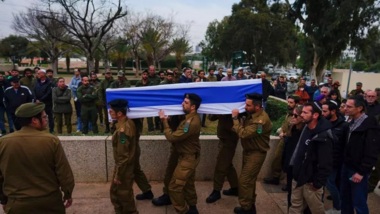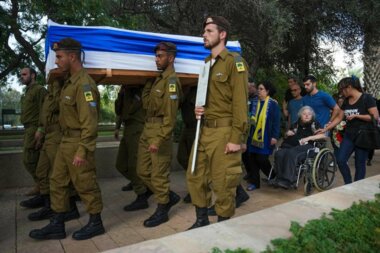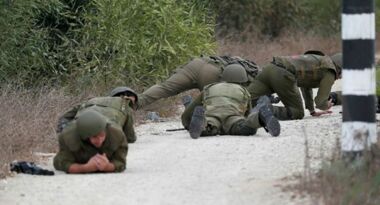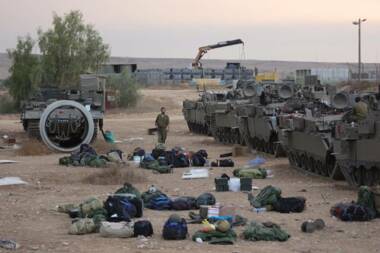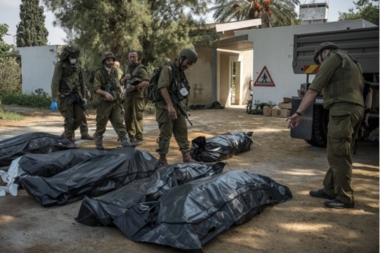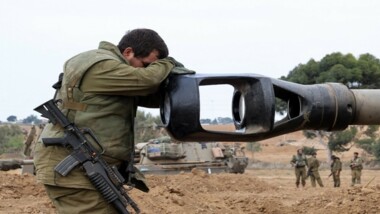
SANA'A February 04. 2024 (Saba) - The ongoing “Al-Aqsa Flood” battle against the Zionist enemy entity since the seventh of last October represented a major historical turning point in the course of the Palestinian issue, for several reasons, most notably the shock that the enemy and the world received with its military fragility and security weakness, compared to the capabilities of the resistance factions in the besieged Gaza Strip.
On the morning of last October 7, the Zionist enemy entity subjected to a “historic catastrophe” after a massive land, sea and air operation carried out by the Al-Qassam Brigades in the Gaza Strip, which resulted in the death dozens of enemy officers and several Zionist military sites.
Perhaps one of the most important things that distinguished the blessed battle of “Al-Aqsa Flood” is that it surpassed its counterparts during the past years in several aspects, most notably the heavy losses incurred by the Zionist enemy, whether in lives or equipment.
The so-called deputy and head of the Foreign Affairs and Security Committee in the Zionist Knesset, Zvi Hauser, confirms, in an article in the Zionist newspaper Yedioth Ahronoth, that the occupying entity lost its deterrence strategy on October 7th.
With the start of the ground battles in northern Gaza on the 27th of last October, what the Zionist enemy was expecting, “a lightning battle after days of insane bombing,” turned into a long and harsh battle of attrition that began from Beit Hanoun and Beit Lahia in the north, then Shuja’iyya and Jabalia, all the way to Khan Yunis in the south.
According to the announced statistics of the Zionist enemy army, the number killed has reached more than 570 officers and soldiers since the start of the aggression on the Gaza Strip on the seventh of last October.
According to the statistics of the Qassam Brigades only, the Zionist enemy army lost many times its announced numbers. It is known for its extreme secrecy about its losses, and the number of vehicles destroyed by the resistance approached about 1,060 vehicles since the beginning of the aggression.
Compared to the past, the Zionist enemy army launched the first large-scale attack on the Gaza Strip, on December 27, 2008, with an operation it called (Cast Lead), while the Palestinian resistance called it (the Battle of Al-Furqan), and it lasted about 23 days.
The Zionist enemy announced that it lost 14 people during this battle, including 12 soldiers and two settlers, while the number of wounded exceeded 300, half of whom were soldiers.
In the year 2014 AD, the Zionist enemy began a military operation at dawn on July 8 in the Gaza Strip, called “Operation Protective Edge.” On the other hand, the Al-Qassam Brigades launched the “Devouring Storm” battle in response to the Zionist aggression.
At the time, the Al-Qassam Brigades announced the capture of a Zionist soldier named “Aaron Shaul” while its fighters confronted a ground incursion by the army. The government of the Zionist enemy also announced the loss of another soldier in the city of Rafah, Hamas said at another time that he was in its control.
64 soldiers and officers were killed in the Zionist enemy army, in addition to six settlers, among the dead soldiers were those who also held other nationalities, such as American, Belgian, and French. The number of wounded reached 720, in addition to the huge economic losses that reached 560 million dollars in the tourism sector, and 370 million dollars among others.
As for the year 2021 AD, the Battle of (Sword of Jerusalem), which the Zionist enemy called (Guardian of the Walls), broke out in May of the same year, after settlers seized the homes of Jerusalemites in the Sheikh Jarrah neighborhood, and the repeated raids on Al-Aqsa Mosque.
During the battle, the Palestinian resistance launched more than four thousand rockets towards the occupied territories, some of which had a range exceeding 250 kilometers, and some of which landed on Ramon Airport, killing 12 soldiers and Zionist settlers and wounding about 330 others.
As for the current battle, the “Al-Aqsa Flood,” the high number of Zionist deaths was sparked by the increase in the number of Zionist deaths, which was initiated by the Hamas movement and in which several factions of the Palestinian resistance participated.
Professor of Zionist Studies at the Egyptian Ain Shams University, Dr. Muhammad Abboud, in statements reported by Asharq Al-Awsat newspaper, attributed the high number of Zionist deaths during the “Al-Aqsa Flood” to several reasons, including “element of the surprise.”
Abboud said: “The Palestinian factions were able to choose zero hour as a surprise to Israel, on a religious and weekly holiday in which a state of relaxation usually prevails in various Zionist sites.”
Meanwhile, the Egyptian military expert, Major General Muhammad Ali Bilal, said in statements to Asharq Al-Awsat that the most important indication of the increase in the number of deaths of the Zionist enemy during the “Al-Aqsa Flood” battle is that it highlights that “the Palestinian resistance has greatly developed its capabilities.”
Bilal says: "The operation proved that the resistance has great capabilities, whether human or military and the ability to plan strategically."
According to statistics issued by the so-called “Zionist National Security Office” in 2014, and published by Zionist newspapers, the number of deaths of the Zionist entity during the Arab-Zionist conflict reached 23,169 people.
The statistics showed that the number of deaths of the Zionist entity during its wars with the Arab countries was the largest between 1947 and 1948, when the number of deaths reached about 6,500 people. Also, during the War of Attrition in Sinai between 1967 and 1973, about 1,000 Zionist soldiers were killed.
In the 1967 war, the number of deaths of the Zionist enemy army reached 750 soldiers, according to the same statistics, while the number of deaths of the Zionist enemy during the First Lebanon War in 1982 was about 650 soldiers.
The Zionist enemy’s media described the sudden battle of “Al-Aqsa Flood” as “disastrous,” and that Saturday, October 7 “the worst in the history of Israel,” due to the large number of deaths and the collapse of the Zionist military units in the vicinity of Gaza.
The Zionist newspaper “Haaretz” published an article written by the Zionist diplomat and writer Alon Pinkas, entitled (October 7, 2023: A date that will remain a shame for Israel).
The Zionist writer considered the Hamas attack a "horrific Israeli disaster, as the state, led by Prime Minister Benjamin Netanyahu and his army, failed spectacularly to protect its citizens.", as he put it.
Official Zionist statements may not reveal the enemy's losses in Gaza, but medical reports from inside Tel Aviv indicate that the Zionist enemy's army suffered in Gaza what it had not suffered in any war before.
According to what was reported by the British newspaper "The Telegraph", a prominent medical official in the ranks of the Zionist enemy army named Avi Yanov revealed this.
M.M
On the morning of last October 7, the Zionist enemy entity subjected to a “historic catastrophe” after a massive land, sea and air operation carried out by the Al-Qassam Brigades in the Gaza Strip, which resulted in the death dozens of enemy officers and several Zionist military sites.
Perhaps one of the most important things that distinguished the blessed battle of “Al-Aqsa Flood” is that it surpassed its counterparts during the past years in several aspects, most notably the heavy losses incurred by the Zionist enemy, whether in lives or equipment.
The so-called deputy and head of the Foreign Affairs and Security Committee in the Zionist Knesset, Zvi Hauser, confirms, in an article in the Zionist newspaper Yedioth Ahronoth, that the occupying entity lost its deterrence strategy on October 7th.
With the start of the ground battles in northern Gaza on the 27th of last October, what the Zionist enemy was expecting, “a lightning battle after days of insane bombing,” turned into a long and harsh battle of attrition that began from Beit Hanoun and Beit Lahia in the north, then Shuja’iyya and Jabalia, all the way to Khan Yunis in the south.
According to the announced statistics of the Zionist enemy army, the number killed has reached more than 570 officers and soldiers since the start of the aggression on the Gaza Strip on the seventh of last October.
According to the statistics of the Qassam Brigades only, the Zionist enemy army lost many times its announced numbers. It is known for its extreme secrecy about its losses, and the number of vehicles destroyed by the resistance approached about 1,060 vehicles since the beginning of the aggression.
Compared to the past, the Zionist enemy army launched the first large-scale attack on the Gaza Strip, on December 27, 2008, with an operation it called (Cast Lead), while the Palestinian resistance called it (the Battle of Al-Furqan), and it lasted about 23 days.
The Zionist enemy announced that it lost 14 people during this battle, including 12 soldiers and two settlers, while the number of wounded exceeded 300, half of whom were soldiers.
In the year 2014 AD, the Zionist enemy began a military operation at dawn on July 8 in the Gaza Strip, called “Operation Protective Edge.” On the other hand, the Al-Qassam Brigades launched the “Devouring Storm” battle in response to the Zionist aggression.
At the time, the Al-Qassam Brigades announced the capture of a Zionist soldier named “Aaron Shaul” while its fighters confronted a ground incursion by the army. The government of the Zionist enemy also announced the loss of another soldier in the city of Rafah, Hamas said at another time that he was in its control.
64 soldiers and officers were killed in the Zionist enemy army, in addition to six settlers, among the dead soldiers were those who also held other nationalities, such as American, Belgian, and French. The number of wounded reached 720, in addition to the huge economic losses that reached 560 million dollars in the tourism sector, and 370 million dollars among others.
As for the year 2021 AD, the Battle of (Sword of Jerusalem), which the Zionist enemy called (Guardian of the Walls), broke out in May of the same year, after settlers seized the homes of Jerusalemites in the Sheikh Jarrah neighborhood, and the repeated raids on Al-Aqsa Mosque.
During the battle, the Palestinian resistance launched more than four thousand rockets towards the occupied territories, some of which had a range exceeding 250 kilometers, and some of which landed on Ramon Airport, killing 12 soldiers and Zionist settlers and wounding about 330 others.
As for the current battle, the “Al-Aqsa Flood,” the high number of Zionist deaths was sparked by the increase in the number of Zionist deaths, which was initiated by the Hamas movement and in which several factions of the Palestinian resistance participated.
Professor of Zionist Studies at the Egyptian Ain Shams University, Dr. Muhammad Abboud, in statements reported by Asharq Al-Awsat newspaper, attributed the high number of Zionist deaths during the “Al-Aqsa Flood” to several reasons, including “element of the surprise.”
Abboud said: “The Palestinian factions were able to choose zero hour as a surprise to Israel, on a religious and weekly holiday in which a state of relaxation usually prevails in various Zionist sites.”
Meanwhile, the Egyptian military expert, Major General Muhammad Ali Bilal, said in statements to Asharq Al-Awsat that the most important indication of the increase in the number of deaths of the Zionist enemy during the “Al-Aqsa Flood” battle is that it highlights that “the Palestinian resistance has greatly developed its capabilities.”
Bilal says: "The operation proved that the resistance has great capabilities, whether human or military and the ability to plan strategically."
According to statistics issued by the so-called “Zionist National Security Office” in 2014, and published by Zionist newspapers, the number of deaths of the Zionist entity during the Arab-Zionist conflict reached 23,169 people.
The statistics showed that the number of deaths of the Zionist entity during its wars with the Arab countries was the largest between 1947 and 1948, when the number of deaths reached about 6,500 people. Also, during the War of Attrition in Sinai between 1967 and 1973, about 1,000 Zionist soldiers were killed.
In the 1967 war, the number of deaths of the Zionist enemy army reached 750 soldiers, according to the same statistics, while the number of deaths of the Zionist enemy during the First Lebanon War in 1982 was about 650 soldiers.
The Zionist enemy’s media described the sudden battle of “Al-Aqsa Flood” as “disastrous,” and that Saturday, October 7 “the worst in the history of Israel,” due to the large number of deaths and the collapse of the Zionist military units in the vicinity of Gaza.
The Zionist newspaper “Haaretz” published an article written by the Zionist diplomat and writer Alon Pinkas, entitled (October 7, 2023: A date that will remain a shame for Israel).
The Zionist writer considered the Hamas attack a "horrific Israeli disaster, as the state, led by Prime Minister Benjamin Netanyahu and his army, failed spectacularly to protect its citizens.", as he put it.
Official Zionist statements may not reveal the enemy's losses in Gaza, but medical reports from inside Tel Aviv indicate that the Zionist enemy's army suffered in Gaza what it had not suffered in any war before.
According to what was reported by the British newspaper "The Telegraph", a prominent medical official in the ranks of the Zionist enemy army named Avi Yanov revealed this.
M.M
resource : SABA
